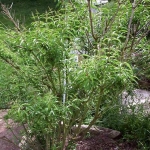| Common Name: |
Lemon verbena |
| Botanical Name: |
Aloysia triphylla syn. Lippia citriodora |
| Genus: |
Aloysia |
| Family: |
Verbenaceae |
| Cultivation: |
Light, well-drained soil in sun. Cut back main stems to 30cm (12in) and side shoots to tow or three buds of the old wood in spring, or remove dead wood in early summer. Plants grown outdoors in cold areas may not show signs of new growth until early summer. |
| Propagation: |
By softwood or greenwood cuttings in summer. |
| Harvest: |
Leaves are picked in summer; used mainly fresh for oil extraction or flavoring, or dried for infusions and potpourris. |
| Native Location: |
Argentina and Chile |
| Height: |
3m (10ft) |
| Width: |
3m (10ft) |
| Hardiness: |
Z8-11 |
| Parts Used: |
Leaves, oil |
| Properties: |
An astringent, aromatic herb, rich in volatile oils, that acts as a mild sedative, relieving spasms, especially of the digestive system, and reducing fever. The essential oil is both insecticidal and bactericidal. |
| Medicinal Uses: |
Internally for feverish colds and indigestion. In aromatherapy for nervous or digestive problems; for acne, boils, and cysts. |
| Culinary Uses: |
Fresh leaves are used in herb teas and to flavor jellies, summer drinks, stuffings for poultry, salads, and salad dressings. |
| Economic Uses: |
Dried leaves are used in potpourris. |
| Bibliography: |
Encyclopedia of Herbs by Deni Brown. Copyright © 1995, 2001 Dorling Kindersley Limited. pp 115-116
|

